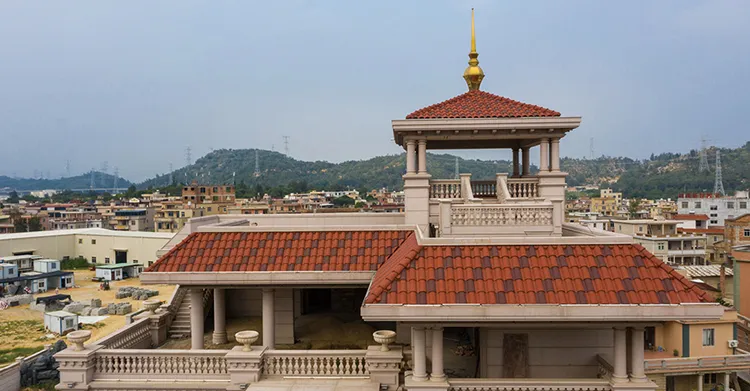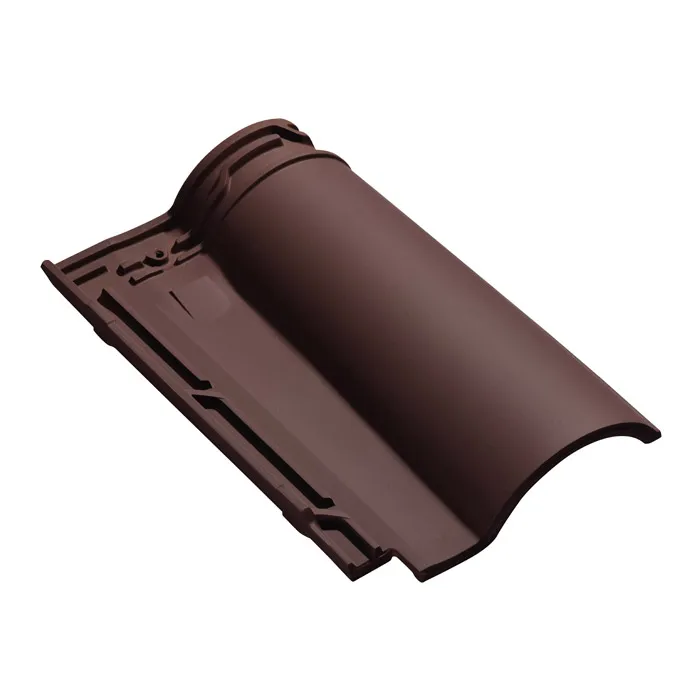Clay roof tiles have become the preferred material for roofs in many buildings due to their excellent durability, classic aesthetic design and adaptability to the environment. Although clay tiles have been used as roof covering materials for hundreds of years, they still remain widely used in modern buildings. There are many factors to consider during the construction of clay tile roofs, especially the size of the gap between tiles and the degree of overlap of tiles, which are key factors to ensure the durability and waterproof performance of the roof.
This article will explore these issues in detail and analyze how to properly adjust the gap and overlap of tiles during roof laying to ensure the best protection and aesthetic effect.

What is the role of clay roof tiles?
To understand the gap and overlap between clay tiles, it is first necessary to clarify the main function of clay tiles on the roof. The arrangement of tiles is not only for decoration, but also undertakes multiple functions:
1. Waterproof function: The most important task of clay tiles is to prevent rainwater from penetrating into the building. Through reasonable overlap between tiles and tight gap control, the roof can effectively prevent water from penetrating through the gaps.
2. Ventilation function: Clay tile roofs require proper ventilation to prevent heat accumulation and stagnation of humid air. Therefore, the gaps between tiles cannot be too tight, otherwise it will affect the natural ventilation of the roof.
3. Wind resistance: In strong wind areas, the gap and overlap design of roof tiles must take into account the impact of wind force to ensure that the tiles are not lifted by the wind.
4. Compatibility of supporting structure: Clay tiles are heavy, the structural design of the roof must be able to withstand the weight of the tiles, and the arrangement of tiles must also be closely integrated with the supporting structure of the roof to ensure stability.
After understanding these functional requirements, we can better understand the design principles of the gap and overlap between clay tiles.
How big is the gap between clay roof tiles?
The gap between clay tiles directly affects the waterproof performance of the roof and the stability of the overall structure. If the gap between tiles is too large, rainwater may penetrate into the internal structure of the roof through the gap, causing leakage problems; if the gap is too small, it may affect the ventilation effect of the tiles, increase heat accumulation, and even cause friction between tiles when the temperature changes, resulting in cracks or breakage.
1. Ideal tile gap
The design of clay tiles usually allows a certain gap between tiles, which is not only for the convenience of laying and adjusting tiles, but also provides the necessary space for thermal expansion of tiles. In actual construction, the gap between tiles usually varies according to the type, shape and installation method of tiles, but in general, the gap between clay tiles should be kept between 3 and 5 mm. This gap range can provide sufficient ventilation without affecting the waterproof performance of the roof.
● Risk of too large gap: If the gap between tiles exceeds 5 mm, rainwater and debris may penetrate the roof through these gaps, thereby weakening the waterproof ability of the roof. In addition, too large a gap may also cause the tiles to move more in strong winds, increasing the risk of tiles being lifted or falling off.
● Risk of too small a gap: If the gap between tiles is less than 3 mm, the tiles may squeeze each other due to thermal expansion when the temperature changes, causing the tiles to crack or be damaged. At the same time, too small a gap will also affect the natural ventilation of the roof and increase the problem of heat accumulation.
2. Climate Effects on Gaps
The design of tile gaps should also take into account local climate conditions. In areas with more humid climates, the gaps between tiles may be slightly larger to ensure that the tile surface can drain quickly and prevent moisture from accumulating between tiles, thereby reducing damage to tiles caused by long-term moisture retention.
In areas with large temperature changes, the gap design of tiles also needs to take into account the effects of thermal expansion and contraction. Clay tiles expand slightly when the temperature is high and contract in cold conditions, so proper gap design can effectively reduce the risk of tiles cracking due to squeezing during these processes.

How much overlap should clay tiles have?
The overlap of clay tiles is not just for aesthetics, but is the key to waterproofing and structural stability. Correct overlap ensures the waterproof performance of the roof because the overlapping parts of the tiles form a "waterproof layer" of the roof to prevent rainwater from seeping in through the gaps between the tiles. The overlap of clay tiles mainly depends on the following factors:
1. Standard overlap ratio
Generally speaking, the overlap ratio of clay tiles is usually between 30% and 50% of the total length of the tile. This ratio ensures that there is enough coverage between tiles to form an effective waterproof layer and prevent rainwater from penetrating into the roof structure from the overlapping area.
● Risk of too little overlap: If the overlap ratio of tiles is less than 30%, rainwater may penetrate under the tiles through the overlapping area in heavy rain or strong wind, causing roof leaks. Too little overlap may also weaken the overall stability of the tiles, especially in windy areas, where the connection between tiles is fragile and easily blown away by the wind.
● Impact of too much overlap: Although too much overlap of tiles will not directly lead to waterproofing problems, too much overlap will increase the material usage of the roof, thereby increasing construction costs. At the same time, too much overlap may affect the ventilation effect of the roof and cause heat accumulation.
2. Relationship between overlap and tile shape
Clay tiles come in a variety of shapes, and different types of tiles have different requirements for the degree of overlap. For example, the overlap area of flat tiles is usually larger, while the overlap area of curved tiles is relatively smaller. The specific overlap ratio should be determined according to the shape and design requirements of the tiles to ensure the installation stability and waterproof effect of the tiles.
3. The influence of roof slope on overlap
The slope of the roof is also one of the important factors affecting the overlap ratio of tiles. Generally speaking, the steeper the roof slope, the overlap ratio of tiles can be appropriately reduced, while on roofs with smaller slopes, the overlap ratio of tiles needs to be increased to ensure that rainwater can be discharged smoothly without seeping under the tiles.
● Steep slope roof: On steep slope roofs, rainwater can flow down the roof surface quickly, so the overlap ratio of tiles can be kept close to 30%.
● Gentle roof: On roofs with smaller slopes, rainwater flows slowly, so the overlap ratio of tiles needs to be increased, usually between 40% and 50%, to ensure that rainwater does not stay between tiles.

How to correctly determine the gap and overlap of tiles?
In order to ensure that the gap and overlap of clay tiles achieve the best effect, construction personnel should combine the following principles in actual operation:
1. Roof design requirements: The gap and overlap of clay tiles should be determined according to the design requirements of the roof. Before construction, it is necessary to understand the specific requirements in the architectural design drawings in detail, including the slope of the roof, the supporting structure, and the arrangement of tiles. These design details will directly affect the installation method and overlap ratio of the tiles.
2. Tile manufacturer's advice: Different clay tile manufacturers usually provide detailed installation guidelines, and the recommended tile gaps and overlap ratios will also vary. During the construction process, strictly following the manufacturer's installation guidelines can ensure the best performance and longest service life of the tiles.
3. Local climatic conditions: As mentioned above, climatic conditions have an important impact on the gaps and overlaps of tiles. Construction personnel should reasonably adjust the gaps and overlaps of tiles according to local climatic characteristics. For example, in rainy areas, the gaps and overlap ratios should be appropriately increased to ensure the waterproof performance of the roof.
At Rongguan, we pride ourselves on being a comprehensive manufacturer of high-quality building materials, including quartz stone countertops, terrazzo flooring, and Spanish-style clay roof tiles. Our factory-direct pricing ensures cost-effective solutions for wholesalers, while our dedication to innovation and design guarantees customer satisfaction. Contact us for special offers and customized orders.

